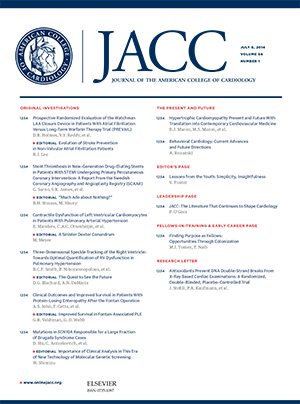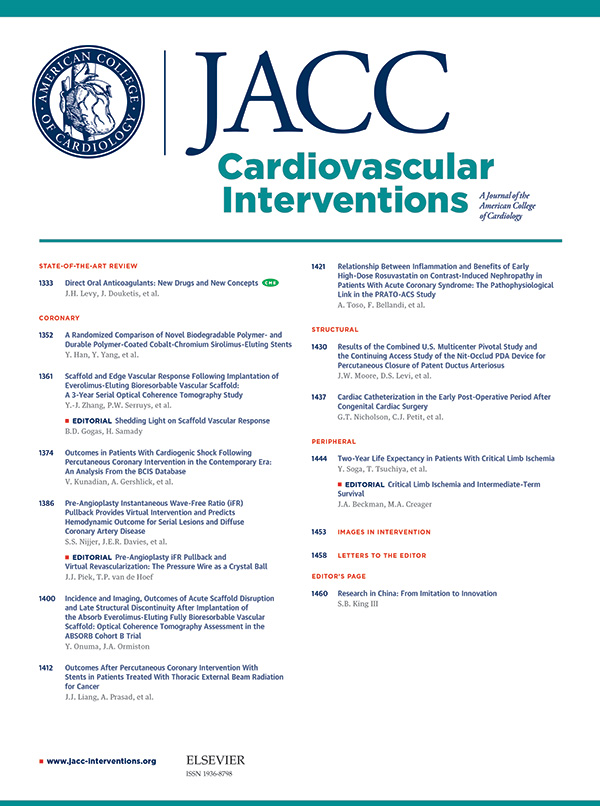JACC in a Flash
Featured topics and Editors' Picks from all of ACC's JACC Journals.
Is Lung Disease Independently Associated With CVD?

Lung disease may be independently associated with cardiovascular diseases, particularly ischemic heart disease (IHD) and heart failure (HF), which contribute significantly to all-cause mortality, according to research published in the Journal of the American College of Cardiology and presented at ACC.19.
Paul Carter, MBChB, et al., looked at 31,646 chronic obstructive pulmonary disease (COPD) patients, 60,424 asthma patients and 1,662 interstitial lung disease (ILD) patients, all of whom were admitted to seven National Health Service hospitals in England between Jan. 1, 2000 and March 31, 2013. Control groups comprised 158,230, 302,120 and 8,310 patients respectively.
Results showed COPD was independently associated with IHD, HF, atrial fibrillation and peripheral vascular disease, all of which were associated with all-cause mortality. Asthma was independently associated with IHD, and multiple cardiovascular diseases contributed to mortality. ILD was independently associated with IHD and HF, both of which were associated with mortality. Yet, researchers also noted that patients with COPD, asthma and ILD were less likely to receive coronary revascularization compared with patients without lung conditions.
These findings are in keeping with those of smaller previous studies. However, the researchers state this is the first study to demonstrate that IHD is independently associated with all-cause mortality in patients with ILD. Similarly, "the study is the first to demonstrate an independent association between ILD and heart failure, and the first to show that heart failure is independently associated with all-cause mortality in ILD, with an associated 1.6-fold increased risk," they said. Looking ahead, "elucidation of the pathophysiological mechanisms underlying the relationship between respiratory disease and cardiovascular disease is urgently required."
Carter P, Lagan J, Fortune C, et al. J Am Coll Cardiol 2019;Mar 4:[Epub ahead of print].
Earlier AVR Better Results?

While class I indications for surgery, mainly symptoms, are the most common triggers for aortic valve surgery (AVR), class II indications may be associated with better postoperative outcomes, based on new data published in the Journal of the American College of Cardiology and presented at ACC.19.
Li-Tan Yang, MD, et al., examined 748 patients with significant aortic regurgitation (AR) without prior heart surgery, myocardial infarction or overt coronary artery disease between 2006 and 2017. The median age of study participants was 58 and 82 percent were men; 387 were treated medically vs. 361 who had AVR. Of the AVR patients, 93 percent met guideline criteria (79 percent with class I indications, 14 percent with class II indications, 7 percent without class I or II indications opted for surgery).
At a median follow-up of 4.9 years, 175 patients (17 percent) had died. Researchers noted that a LV end-systolic dimension increase (LVESDi) >20 mm/m2 was associated with an increased risk of death. Additionally, AVR was associated with better survival – a finding suggesting that AVR should be considered at an earlier stage of chamber enlargement.
"Class II indications were associated with better postoperative outcome and thus merit more attention," researchers said. "LVESDi was the only LV parameter independently associated with all-cause mortality and the ideal cut-off seems to be lower than previously recommended."
In a related editorial, Patrick T. O'Gara, MD, MACC, and Yee-Ping Sun, MD, FACC, caution the study is limited by being a single center, retrospective analysis that can't account for several variables impacting both total and cardiovascular mortality, including intensity of medical supervision and echocardiographic surveillance before and after referral; the rigor of long-term postoperative care; and emergence of other comorbidities following surgery.
They write that nevertheless, one important takeaway from this and other studies "is that isolated [AVR] for AR in the modern era can be performed with very low perioperative risk in appropriately selected patients at high volume centers of excellence." They highlight that "it will be important to establish whether such results can be generalized."
Yang L-T, Michelena HI, Scott CG, et al. J Am Coll Cardiol 2019;Mar 4:[Epub ahead of print].
Novel Aortic Root Anatomical Classification System and TAVR

Using a unique aortic root anatomical classification may help determine the feasibility of deploying a second S3 transcatheter aortic valve (TAV) within a previously implanted S3 TAV (TAV-in-TAV), according to research published in JACC: Cardiovascular Interventions and presented at ACC.19.
Gilbert H.L. Tang, MD, MSc, MBA, FACC, et al., evaluated postdeployment aortography in 484 S3 TAVR patients to determine the risk of left main coronary obstruction with TAV-in-TAV.
Three aortic root types were defined based on sinotubular junction (STJ) diameter and sinus height (SH) relative to the transcatheter valve diameter (TVD) and height. Researchers determined that TAV-in-TAV was not feasible within an S3 valve if the valve-to-sinus distance and/or valve-to-sinus height was 2 mm or less given the possibility of coronary obstruction.
There was no difference between the feasible and not feasible groups for SH, but the not feasible group had significantly smaller minimum, maximum and mean STJ diameters in Type 2 root for 29S3 valves, and in Type 3 root for 23S3, 26S3 and 29S3 valves. Overall, TAV-in-TAV was not feasible in 20 percent of patients assessed.
The authors suggest that aortic root type, STJ and SH be routinely evaluated to determine valve selection and positioning for TAV-in-TAV, something that becomes more important as younger patients undergo TAVR.
Tang GHL, Zaid S, Gupta E, et al. JACC Cardiovasc Interv 2019;Mar 4:[Epub ahead of print].
CHAMP-HF: Underdosing in HFrEF

Most patients with heart failure with reduced ejection fraction (HFrEF) did not receive target doses of medical therapy during follow-up and few patients had dose increases over time in an analysis of the CHAMP-HF registry, published in the Journal of the American College of Cardiology and presented during ACC.19.
Current guidelines for patients with HFrEF recommend the use of multiple evidence-based medications titrated to the target dose from landmark clinical trials, as tolerated. The aim of this analysis, reported by Stephen J. Greene, MD, et al., was to assess the practice patterns of longitudinal titration of guideline-directed medical therapy in routine U.S. clinical practice, clinical factors associated with dose increases and decreases, and underlying reasons for medication changes.
CHAMP-HF was a prospective observational study of patients with HFrEF receiving ≥1 HF medication at enrollment. Four medication classes were evaluated in 2,588 eligible patients: angiotensin-converting enzyme inhibitors (ACEI)/angiotensin II receptor blockers (ARB), angiotensin receptor-neprilysin inhibitors (ARNI), evidence-based beta-blockers and mineralocorticoid receptor antagonists (MRA). The use and dose of the medications were assessed at baseline and 12-months follow-up.
At baseline, the percentage of patients receiving target doses for beta-blocker, ACEI/ARB, MRA and ARNI were 20.3, 11.1, 25.4 and 1.7 percent, respectively. At 12 months, rates of medication initiation or dose increase were 7.0, 9.9, 9.9 and 6.3 percent for ACEI/ARB, ARNI, beta-blocker and MRA, respectively. Rates of discontinuation and dose decrease were 11.5, 2.5, 6.6 and 4.4 percent for ACEI/ARB, ARNI, beta-blocker and MRA, respectively.
"Further quality improvement efforts are urgently needed to improve guideline-directed medication titration in routine practice," the authors conclude.
Greene SJ, Fonarow GC, DeVore AD, et al. J Am Coll Cardiol 2019;Mar 4:[Epub ahead of print].
BNP and NT-proBNP Equally Predict Sacubitril/Valsartan Outcomes

B-type natriuretic peptide (BNP) is shifted to the right during treatment with sacubitril/valsartan but remains a clinically valid biomarker with independent prognostic value similar with that of N-terminal pro-BNP (NT-proBNP). The findings come from an analysis of the PARADIGM-HF trial published in the Journal of the American College of Cardiology and presented at ACC.19.
PARADIGM-HF compared the long-term efficacy and safety of sacubitril/valsartan vs. enalapril in patients with heart failure with reduced ejection fraction. In this report, Peder Langeland Myhre, MD, PhD, et al., evaluated the relative prognostic value of BNP and NT-proBNP before and during treatment with sacubitril/valsartan.
BNP levels at 8 to 10 weeks of treatment were available for 24 percent (n=2,001) of all PARADIGM-HF patients. Median BNP increased from 202 ng/L to a peak median concentration of 235 ng/L after 8 to 10 weeks of sacubitril/valsartan and decreased to a median 181 ng/L after 8 to 10 weeks of enalapril treatment. During 8 to 10 weeks of treatment with sacubitril/valsartan, BNP increased by a median of 19 percent vs. a median decrease of 28 percent in NT-proBNP.
In patients treated with enalapril, BNP decreased by a median of 6 percent compared with a 5 percent decrease in NT-proBNP. No significant difference was found between BNP and NT-proBNP in predicting outcomes at any timepoints during the study.
The authors conclude that, if available, NT-proBNP measurement is preferred to avoid clinical confusion during drug initiation with sacubitril/valsartan. However, if the NT-proBNP assay is not available, BNP measurement has comparable performance with respect to clinical prognosis. They also note that BNP should not be used to determine treatment adherence or response in individual patients.
Langeland Myhre P, Vaduganathan M, Claggett B, et al. J Am Coll Cardiol 2019;Mar 4:[Epub ahead of print].
Impact of DAPT Cessation Differs Significantly With Age

While older age may be associated with higher incidence of dual antiplatelet therapy (DAPT) cessation due to discontinuation or interruption, disruption displays a bimodal pattern that may occur more frequently in both younger and older patients, according to research published in JACC: Cardiovascular Interventions and presented at ACC.19.
Lauren C. Joyce, BS, et al., used data from the PARIS registry to examine two-year clinical outcomes as well as incidence and effect of DAPT cessation after PCI compared by age. DAPT cessation included physician-recommended discontinuation, interruption for surgery and disruption.
Clinical endpoints included major adverse cardiac events (MACE) – composite of cardiac death, definite or probable stent thrombosis, spontaneous myocardial infarction (MI) or clinically indicated target lesion revascularization – and a secondary restrictive definition of MACE (MACE2) – defined as cardiac death, definite or probable stent thrombosis and spontaneous MI.
Results showed that of 5,018 patients, 1,192 patients were ≤55 years, 2,869 were 56-74 years and 957 were ≥75 years. Patients ≥75 years were found to have higher DAPT cessation rates and increased risk of MACE2, death, cardiac death and bleeding vs. younger patients.
However, discontinuation and interruption were not associated with increased cardiovascular risk across age groups. Disruption was associated with increased risk for MACE and MACE2 in younger patients but not in patients ≥75 years.
The authors note the high incidence of adverse events found among the oldest age group was expected as this population is typically burdened with more comorbidity. In contrast, because age wasn't a modifier of risk of adverse cardiovascular events after discontinuation or interruption, the results should support the use of physician-recommended discontinuation and interruption as safe clinical practices.
"Future prospective studies should be conducted to investigate the safety and efficacy of shortened DAPT in older patients," the authors conclude. "In younger patients, strategies should be developed to optimize medication adherence and mitigate risk for adverse cardiovascular events after disruption."
Joyce LC, Baber U, Claessen BE, et al. JACC Cardiovasc Interv 2019;Mar 4:[Epub ahead of print].
Clinical Topics: Anticoagulation Management, Arrhythmias and Clinical EP, Cardiac Surgery, Cardiovascular Care Team, Heart Failure and Cardiomyopathies, Invasive Cardiovascular Angiography and Intervention, Noninvasive Imaging, Valvular Heart Disease, Atherosclerotic Disease (CAD/PAD), Anticoagulation Management and Atrial Fibrillation, Atrial Fibrillation/Supraventricular Arrhythmias, Aortic Surgery, Cardiac Surgery and Arrhythmias, Cardiac Surgery and Heart Failure, Cardiac Surgery and VHD, Acute Heart Failure, Heart Failure and Cardiac Biomarkers, Interventions and Coronary Artery Disease, Interventions and Imaging, Interventions and Structural Heart Disease, Interventions and Vascular Medicine, Angiography, Echocardiography/Ultrasound, Nuclear Imaging
Keywords: ACC Publications, Cardiology Magazine, Aminobutyrates, Angiotensin Receptor Antagonists, Angiotensin-Converting Enzyme Inhibitors, Aortic Valve, Aortic Valve Insufficiency, Adrenergic beta-Antagonists, Aortography, Asthma, Atrial Fibrillation, Cardiovascular Diseases, Control Groups, Coronary Occlusion, Coronary Artery Disease, Diabetes Mellitus, Type 2, Enalapril, Echocardiography, Follow-Up Studies, Comorbidity, Heart Failure, Lung Diseases, Interstitial, Medication Adherence, Myocardial Infarction, National Health Programs, Mineralocorticoid Receptor Antagonists, Natriuretic Peptide, Brain, Peptide Fragments, Neprilysin, Postoperative Care, Prognosis, Prospective Studies, Pulmonary Disease, Chronic Obstructive, Peripheral Vascular Diseases, Quality Improvement, Referral and Consultation, Registries, Risk Factors, Tetrazoles, Stroke Volume, Retrospective Studies, Transcatheter Aortic Valve Replacement
< Back to Listings

